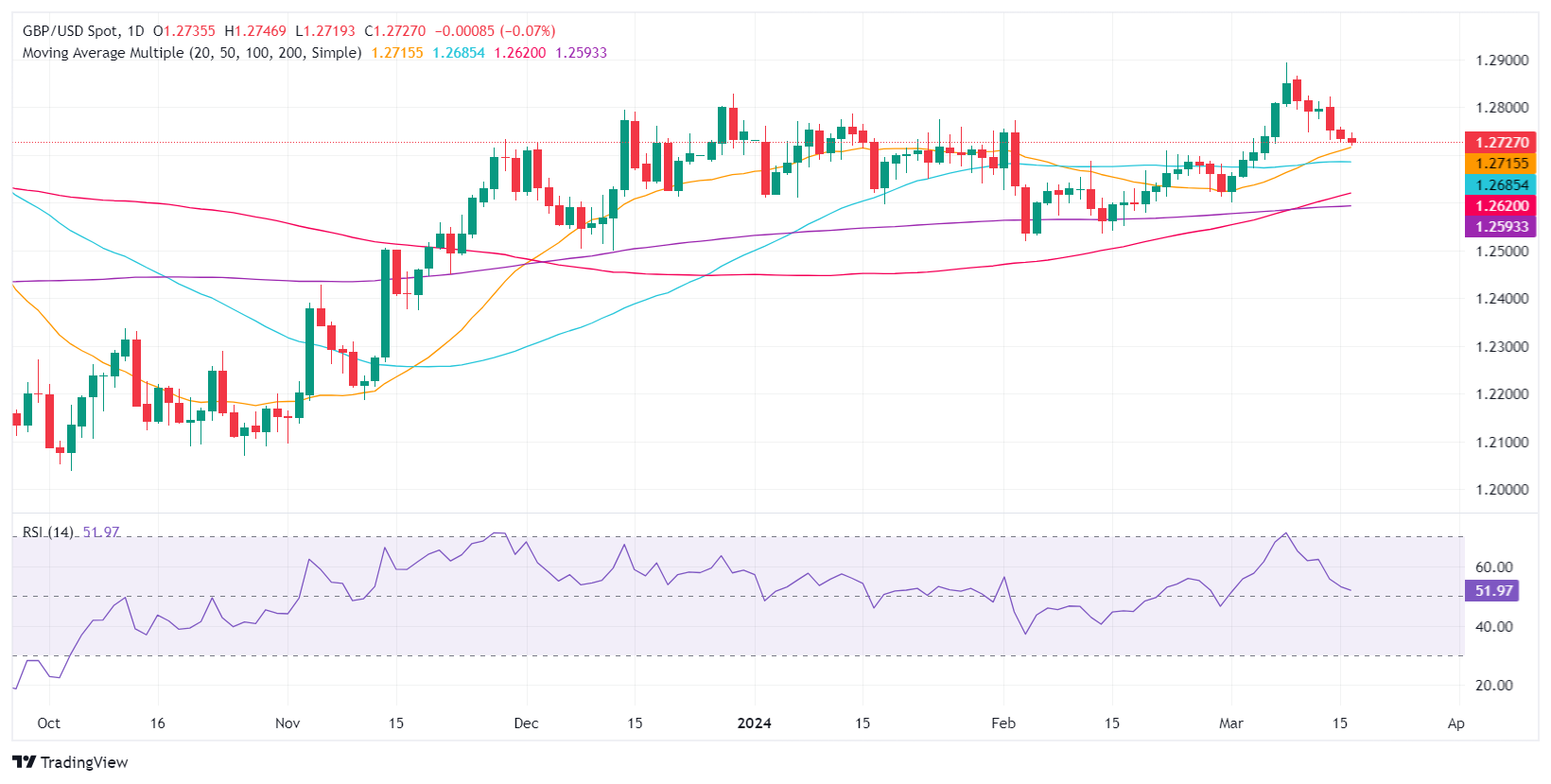GBP/USD stabilizes ahead of key central bank decisions, UK’s inflation in focus

- GBP/USD hold steady as BoE, Fed decisions loom.
- US homebuilders’ confidence rises, mortgage rates may drop if Fed eases.
- UK inflation data pivotal for Sterling pre-BoE decision.
- The GBP/USD is under pressure as unexpected UK CPI may alter BoE policy.
The Pound Sterling losses steam and treads water against the US Dollar as traders prepare for the announcement of major central banks’ monetary policy decisions. The Bank of England and the US Federal Reserve are expected to hold rates unchanged, though a ‘hawkish tilt’ of the Fed might weigh on Sterling; the GBP/USD trades at 1.2727, barely down 0.04%.
Sterling awaits Fed and BoE decisions, as UK inflation could set the tone
This week, the US economic docket will feature housing data on the first two days of the week. Data from the National Association of Home Builders (NAHB) revealed that homebuilders’ confidence rose in March to its highest level since July 2023, as mortgage rates dip, on expectations that the Fed might begin to ease policy. The NAHB Market Index came at 51, up from 48 in February.
Across the pond, UK inflation is due on Wednesday, a day ahead of the BoE’s decision. The Consumer Price Index (CPI) for February is expected to dip from 4% to 3.5% YoY, while core figures are estimated at 4.6% YoY, down from 5.1%.
If UK inflation cools as estimated, that could be negative for Cable, which would likely be under pressure later on Wednesday as the Fed announced its decision and updated its projections. The data could influence Thursday’s BoE decision and tilt the UK’s central bank slightly dovish.
On the other hand, a hotter-than-expected inflation in Britain could underpin the GBP/USD higher, as the BoE would adhere to the mantra of keeping rates “higher for longer.”
GBP/USD Price Analysis: Technical outlook
Since reaching the current year-to-date (YTD) high of 1.2894, the GBP/USD has dived more than 1.30%. if sellers push prices below 1.2700, that could open the door to challenge dynamic support at the 50-day moving average (DMA) at 1.2685. further downside is seen once cleared, at the 100-DMA at 1.2607, followed by the 200-DMA at 1.2590. On the flip side, if buyers lift the exchange rate above last Friday’s high of 1.2758, further upside is seen at 1.2800.
Pound Sterling FAQs
The Pound Sterling (GBP) is the oldest currency in the world (886 AD) and the official currency of the United Kingdom. It is the fourth most traded unit for foreign exchange (FX) in the world, accounting for 12% of all transactions, averaging $630 billion a day, according to 2022 data. Its key trading pairs are GBP/USD, aka ‘Cable’, which accounts for 11% of FX, GBP/JPY, or the ‘Dragon’ as it is known by traders (3%), and EUR/GBP (2%). The Pound Sterling is issued by the Bank of England (BoE).
The single most important factor influencing the value of the Pound Sterling is monetary policy decided by the Bank of England. The BoE bases its decisions on whether it has achieved its primary goal of “price stability” – a steady inflation rate of around 2%. Its primary tool for achieving this is the adjustment of interest rates. When inflation is too high, the BoE will try to rein it in by raising interest rates, making it more expensive for people and businesses to access credit. This is generally positive for GBP, as higher interest rates make the UK a more attractive place for global investors to park their money. When inflation falls too low it is a sign economic growth is slowing. In this scenario, the BoE will consider lowering interest rates to cheapen credit so businesses will borrow more to invest in growth-generating projects.
Data releases gauge the health of the economy and can impact the value of the Pound Sterling. Indicators such as GDP, Manufacturing and Services PMIs, and employment can all influence the direction of the GBP. A strong economy is good for Sterling. Not only does it attract more foreign investment but it may encourage the BoE to put up interest rates, which will directly strengthen GBP. Otherwise, if economic data is weak, the Pound Sterling is likely to fall.
Another significant data release for the Pound Sterling is the Trade Balance. This indicator measures the difference between what a country earns from its exports and what it spends on imports over a given period. If a country produces highly sought-after exports, its currency will benefit purely from the extra demand created from foreign buyers seeking to purchase these goods. Therefore, a positive net Trade Balance strengthens a currency and vice versa for a negative balance.
